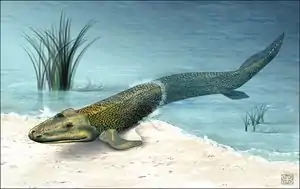:Tiktaalik
Tiktaalik is an extinct genus of fish which lived around 375 million years ago[1].
| We're all Homo here Evolution |
| Relevant Hominids |
| A Gradual Science |
| Plain Monkey Business |
v - t - e |
Unlike modern fish, Tiktaalik had a neck; it both had gills and lungs; it had bones in its fins that resemble the bones in the upper arm, forearm and wrist of land vertebrates; it had ribs that could support its body weight on dry land. [2][3] Given its "neither-fish-nor-fowl" attributes, many scientists see Tiktaalik as a transitional form in the evolution of tetrapods (four-limbed vertebrates, i.e. amphibians, reptiles, birds, and mammals). Scientists call it "the most compelling examples yet of an animal that was at the cusp of the fish-tetrapod transition".[4]
Na na na na na na, we can't hear you

“”What evolutionists fail to see however is that Tiktaalik is actually a fish, much as Archaeopteryx is a bird. |
| —Generic creationist response[5] |
Creationists claim that 397-million-year-old (compare to Tiktaalik's age of 375 million years) fossilized footprints found in Poland show that Tiktaalik could not reveal a transition between water and land animals.[6] However, this argument is based on misunderstanding evolution as a linear progression. Augustine of Hippo's Great Chain of Being is fictional. There is no real reason why a primitive (i.e., resembling the ancestral) morphology could not survive to recent times (hey, coelacanth, how's it going?)
Plausible explanations for the 397-ma fossils include:
- The fossils just aren't tetrapod footprints, but something else.
- The vertebrates made at least two transitions to land, not just one. The members of the transition represented by the Polish tracks all died, but Tiktaalik's descendants are modern tetrapods.
- Tiktaalik and kin have an as yet unknown fossil record which will put their common ancestor with tetrapods between that of tetrapods and lungfish.
Related fossils
The transition from water to land is bridged by several transitional fossils, ranging from amphibian-like fish to fish-like amphibians. One research article[7] gives this list (with the caution that, like most things in evolution, there is no simple straight line):
- Eusthenopteron
- Panderichthyes
- Elginerpeton
- Designathus
- Ventastega
- Metaxygnathus
- Acanthostega
- MGUH VP 6088 (not yet described in the literature)
- Ichthyostega
- Watcheeria
- Pederpes - From smack in the middle of "Romer's Gap
File:Wikipedia's W.svg ", where the tetrapod fossil record goes out to lunch for some 20 million years - Greererpeton
- Crassigyrinus
- Baphetes
- Balanerpeton
- Denderpeton
- Silvanerpeton
- Proterogyrinus
- Eoherpeton
External links
References
- Fossil fish bridges the evolutionary gap between animals of land and sea. October 16, 2008
- Why is Tiktaalik called the "fishapod"?
- The Real Darwin Fish, why creationists hate Tiktaalik.
- John Noble Wilford. Scientists Call Fish Fossil the 'Missing Link'.
- Creation wiki - Tiktaalik
- http://creation.com/polish-tetrapod-footprints-trample-tiktaalik
- Figure 4d in Per E. Ahlberg, Jennifer A. Clack, Ervns Lukevis, Henning Blom & Ivars Zupi: "Ventastega curonica and the origin of tetrapod morphology". Nature 453, 1199-1204 (26 June 2008). doi: 10.1038/nature06991